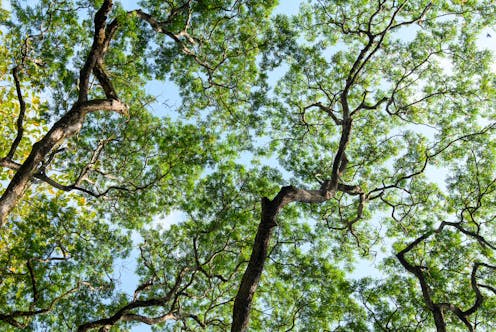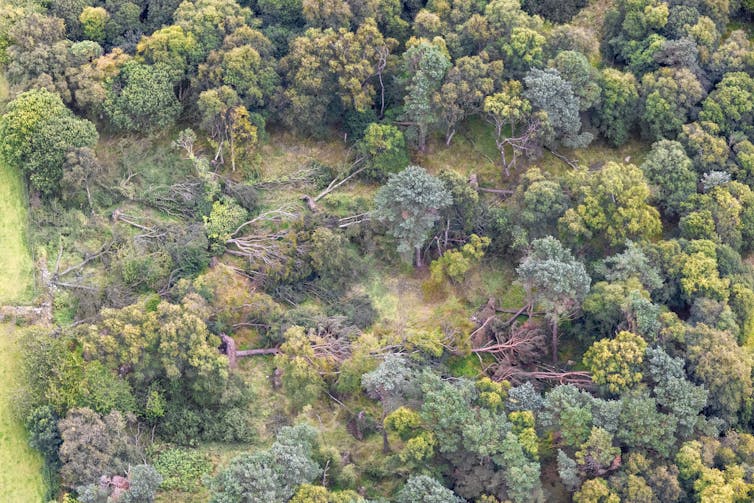Trees compete for space, light and resources, and those clashes can leave battle scars
For trees, growing to maturity involves much more than just reaching upward.

When you walk through a forest, it may feel like a static setting where very little is happening. But trees are constantly interacting and reacting to each other as they grow. There’s intense competition for light and space. Every shift affects the overall makeup of the forest in some way.
Forest scientists like me spend a lot of time thinking about forest succession – a predictable process in which plant species colonize and dominate a piece of land. The basic sequence is for land to evolve from an open field to brush and shrubs, then to young trees and ultimately to large, mature trees. Disturbances, such as a major storm or wildfire, can interrupt or set back forest succession.
I study ecological changes in species composition, tree arrangement and forest development that occur during succession and after disturbances. My research team analyzes conditions in mixed-species deciduous, or leafy, forests. Using tree rings, we reconstruct what previous forests looked like years ago.
By applying observed patterns and processes, researchers can model forests’ future growth and development. Here are some insights into what may be happening among the trees around you on a forest walk.
Jockeying for space and light
Forest communities contain trees of different species, shapes and sizes. Each species needs specific amounts of sunlight and space to thrive and grows at its own rate.
Many trees distance themselves from other trees to minimize interaction with their neighbors – a pattern that researchers call crown shyness. If you look upward, you may notice gaps between trees, and branches near the gaps with broken twigs and fewer leaves. In contrast, branches and leaves that have ample space and sunlight to grow will be denser and healthier.
Mixed-species leafy forests often support more than 30 woody species, which means that they can evolve in many different ways. Understanding how trees interact allows people who manage forests, whether the setting is rural or urban, to prescribe practices that will guide forest growth.
When a forest is first becoming established, it can have thousands of tree seedlings per acre. But only 50 to 100 trees per acre may survive and grow to maturity. Foresters work to understand which trees will outcompete others and which trees will surrender growing space.
One of the most important zones for understanding forest growth is the canopy – the forest’s ceiling, which includes all the leaves, branches and twigs in trees’ crowns. A typical mixed-species forest will have multiple canopy layers, made up of species with varying growth rates. As trees die, they relinquish growing space, which surviving trees capture by growing and expanding their crowns.
How windstorms shape forests
A mature tree will experience many weather events during its lifetime. Windstorms force trees to sway and bump their neighbors, which causes crown abrasion – damage to buds and branch tips. These impacts may slow and reduce branch growth. Crown abrasion is a sign that tree stands are too dense and competition among trees is undermining healthy growth.
However, crown abrasion can actually help some species. For example, oaks, a slower-growing species, have dense tissues and stout branches that can abrade and damage branches of faster-growing trees such as poplar and gum, which have weaker, less dense wood. This allows oaks to emerge above their initially faster-growing rivals.
Some forests are monocultures, dominated by one tree species. For example, in large areas of the Western U.S., forests were burned or clear-cut in the 1800s and later regenerated with lodgepole pine, which is native to Western mountain areas. The trees all grew back at the same rate, unlike mixed forests where some species grow more quickly than others.
This produced tall, slender trees that sway more during windy events. Because of crown abrasion or shyness, the pines have small crowns that don’t expand as far out to the sides as they normally would.
These forests eventually become stagnant. Space between trees shrinks because the trees’ small crowns don’t keep neighboring trees at “arm’s length.” Tree growth diminishes, and the trees’ vitality declines.
Thinning these forests or carrying out prescribed burns can increase spacing between the trees and provide more space for crown growth.
Watching trees battle
To study branch movement during wind events, my students and I use accelerometers – devices that measure how quickly the speed of a moving object changes. Most modern smartphones contain built-in accelerometers that help apps such as Google Maps pinpoint the phone’s position.
We fasten the accelerometers near the ends of branches, where they measure branch movements in three dimensions. By linking this data in real time to wind speed measurements, we can determine branch movements and acceleration in response to different wind speeds.
In one study, we analyzed how interactions among different tree species changed the forest canopy in bottomland hardwood forests along rivers and streams in central Mississippi. These forests were composed mainly of cherrybark oak and sweetgum trees. Both species are common in mixed stands, but they have different crown forms and growth rates.
Initially, sweetgums were more numerous and prominent in young forests. But as time went on, thanks to trees bumping into each other, cherrybark oaks started to become stronger in spaces vacated by abraded sweetgum branches. Eventually, the oak outcompeted the declining sweetgum and came to dominate the forest canopy.

Managing from the top down
Forest environments are constantly changing and are affected by many factors, from insect invasions and plant diseases to climate change and natural disasters. Physical crown abrasion between species is not as well understood as some of these other stresses, but it clearly contributes to the development of diverse, mixed-species deciduous forests.
Our research suggests that when crown abrasion reduces the crown size and growth of faster-growing species, slower-growing stouter species can emerge and become more prominent. This finding can help scientists and foresters develop and manage healthy, productive forests.
Wayne K. Clatterbuck is a member of the Tennessee Forestry Association (TFA), a non-profit organization that promotes forestry in the state (https://www.tnforestry.com/about-tfa). Clatterbuck assists with educational services within TFA.
Read These Next
Who thinks Republicans will suffer in the 2026 midterms? Republican members of Congress
The president’s party almost always loses seats in the midterms. More than two dozen Republican House…
New materials, old physics – the science behind how your winter jacket keeps you warm
Winter jackets may seem simple, but sophisticated engineering allows them to keep body heat locked in,…
Resolve to network at your employer’s next ‘offsite’ – research shows these retreats actually help f
Because they can help you get to know more of your co-workers, offsites may build the kind of trust…






